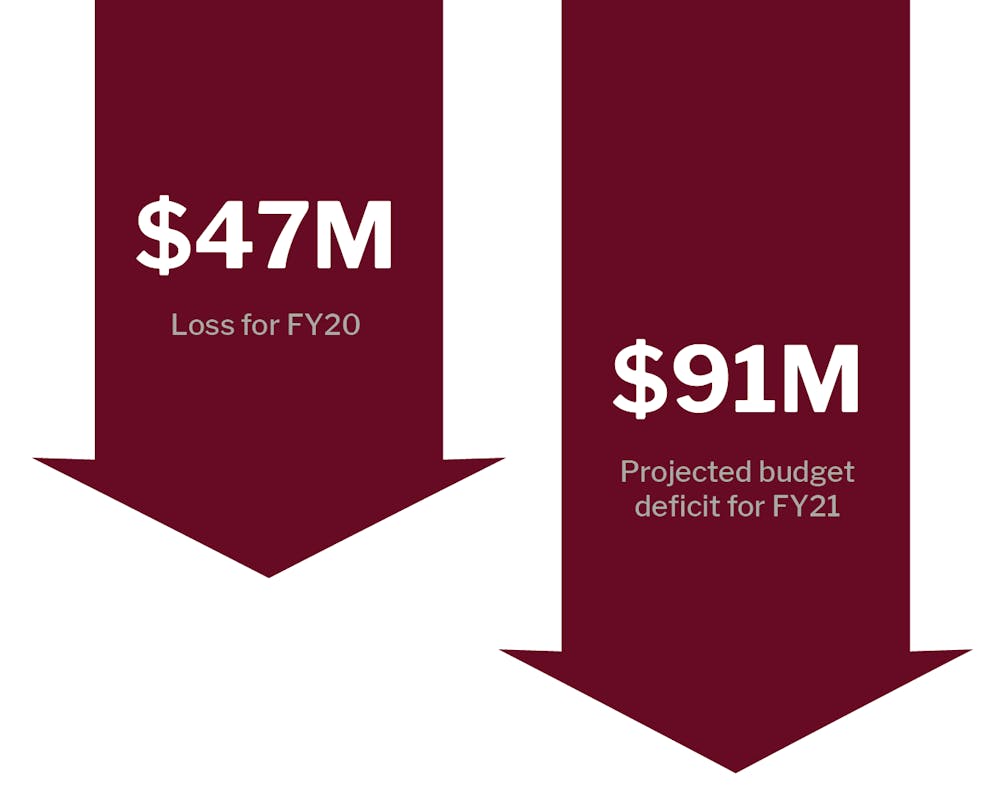
Penn will continue with the 3.9% increase in total cost of attendance for the upcoming academic year, charging about $60,000 for tuition and fees for the 2020-2021 academic year.
Credit: Kylie CooperAfter suffering a $47 million loss this spring due to the coronavirus outbreak, Penn is projecting a $91 million budget deficit for fiscal year 2021.
Executive Vice President Craig Carnaroli and Vice President for Budget, Planning, and Analysis Trevor Lewis detailed the University’s finances on June 25 to Penn faculty as part of the Faculty Senate Seminar Series. The $91 million deficit for FY21 — July 1, 2020 to June 30, 2021 — stems from forgone revenues including tuition, fees, housing, dining, and research funding. The University also anticipates a 15% increase in undergraduate student financial aid for the 2020-2021 academic year budget as students and their families deal with the economic impacts of the ongoing pandemic.

Of the $91 million deficit, $40 million make up one-time costs to support social distancing measures, personal protective equipment, and additional financial aid for students amid the pandemic.
The unplanned $47 million loss in spring 2020 emanates from costs including housing and dining rebates, technology to facilitate remote learning, financial assistance to staff and contracted workers, and grants made to small West Philadelphia businesses.
Carnaroli said endowment spending will increase by 3.7% and cover 16% of the operating budget in FY21. The University will invest in a variety of initiatives including Penn’s health and wellness programs for the community, its Power Purchase Agreement to promote climate sustainability, its student support programs such as Penn First Plus and stipend growth, and the Power of Penn Campaign. Penn will also continue to invest in technologies that support remote teaching and telework.
The University’s academic operating budget is about $3.5 billion for FY21 and $11.3 billion including the University of Pennsylvania Health System.
Earlier this year, Penn initially projected a $148 million budget deficit for FY21 due to the pandemic. To reduce the deficit to $91 million, the University cut $57 million worth of cost through ‘preemptive actions,' as stated in the presentation, such as instituting a hiring freeze on all positions except grant-funded positions approved by the “highest level of the school/center," eliminating mid-year salary budgets, deferring construction projects, and restricting travel and entertainment expenses.
According to the presentation, Penn's revenue is more tuition-dependent than its ‘Ivy Plus Peers,’ which include the Ivy League schools, Duke University, Johns Hopkins University, Stanford University, Massachusetts Institute of Technology, and the University of Chicago. Tuition and fees make up approximately 33% of Penn's budget compared to the 23% average of 'Ivy Plus Peer' budgets.
Some universities in the United States, such as Princeton University and Williams College, have decided to lower their price of attendance to compensate for the predominately remote-learning experience. While the majority of fall instruction at Penn will be delivered online, Penn is not decreasing tuition and will continue with the 3.9% increase in total cost of attendance for the upcoming academic year.
"Penn stands as one of the few universities that commits to meeting 100% of demonstrated need with grant-based financial aid, and our financial aid budget will increase at a rate that goes above and beyond our increases in cost — with more funds dedicated to supporting students than ever before," the presentation's "Follow-up Questions" document stated in response to the tuition increase.
While Penn boasts its generous support for student financial aid, Penn is second to last in the Ivy League for the percentage of undergraduate students who receive financial aid. Only Penn and Brown University dip below 50%, at 45% and 41%, respectively.
Carnaroli and Lewis wrote to The Daily Pennsylvanian that Penn is more dependent on tuition as a source of revenue due to its smaller endowment when compared to its peer institutions. Penn's endowment stands at $14.7 billion as of June 30, 2019, the sixth largest endowment of universities in the U.S. at the end of FY18.
"The cost of a Penn education continues to grow despite the pandemic, and we will need to maintain growth in tuition, one of our primary revenue sources, as planned," the "Follow-up Questions" document read.
Although Penn annually spends a comparable percentage of endowment relative to peer institutions, its relatively smaller endowment and larger total budget means that Penn's endowment supports a smaller portion of overall spending, according to the document.
Less than 15% of Penn’s budget is paid for by its endowment and other short-term "investment vehicles," according to the presentation. In comparison, endowment covers approximately 35% of Harvard's operating revenue and 60% of Princeton's operating revenue every year.
Only 18% of Penn’s academic component of the endowment is unrestricted, and the University invests the income from this endowment portion into its highest priorities as outlined in the Penn Compact, such as undergraduate financial aid and other student and faculty support.
Penn will continue to follow a "well-constructed spending rule" to ensure stable spending and to maintain purchasing power for future generations, according to the "Follow-up Questions" document.
Like Penn, other top universities are enduring financial losses despite their large endowments. As of early May, Harvard University projected a net shortfall of $415 million in revenue for FY20, and an additional $750 million shortfall for the upcoming fiscal year. Cornell University anticipates losses of more than $100 million with a potential longer-term impact for at least the next couple years.
Lewis said that future years will be affected by this past year’s market performance, adding that Penn will likely see a downturn in investment income in FY22.
The Daily Pennsylvanian is an independent, student-run newspaper. Please consider making a donation to support the coverage that shapes the University. Your generosity ensures a future of strong journalism at Penn.
Donate




